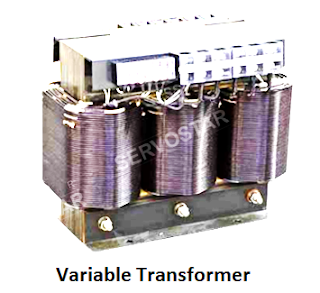What is
Servo Voltage Stabilizer
Servo Voltage Stabilizer right output. associate degree AC electric motor adjusts the voltage in a very right-handed or anticlockwise direction and manages the output voltage with elements like management cards, dimmers, comparators, transistors, mocks, etc.
Main elements and they are operating
The servo voltage stabilizer consists of seven main
components:-
1. rheostat (Variable Transformer)
2. Carbon Brush
3. Servomotor - Synchronizing Motors
4. Buck-Boost electrical device (Series Transformer)
5. Contactor or Relay
6. MCB, MCCB
7. Electronic Circuits
Variable Transformer
it's unremarkably spherical in
form. Si CrGO solid core is employed for the bottom and copper wire with a
particular twist quantitative relation is employed in keeping with the
capability. the essential purpose of a rheostat is to extend or decrease the
voltage that's fed to the buck-boost electrical device. solely five-hundredths
of the output voltage is multiplied or ablated by the rheostat.
Let's take an associate degree example: If the input voltage
is 160V, the rheostat can step it up to 190V, and therefore the remaining 30V
(since 220V is needed to drive any single-phase load) are going to be done by a
Buck-boost electrical device. What is a Servo Controlled Voltage Stabilizer? Why
should I install one?
 |
| VR-Transformer |
1. Variable Transformer - it's commonly spherical in
form. semiconductor CrGO solid core is employed for the bottom and copper wire
with a selected twist magnitude relation is employed in step with the
capability. the fundamental purpose of a variable resistor is to extend or
decrease the voltage that's fed to the buck-boost electrical device. solely
five-hundredths of the output voltage is inflated or cut by the variable
resistor.
Let's take AN example: If the input voltage is 160V, the
variable resistor can step it up to 190V, and therefore the remaining 30V (since
220V is needed to drive any single-phase load) is done by a Buck-boost
electrical device...
2. Carbon Brush - this is often a moving part of the servo
stabilizer, it's mounted within the shaft to form contact with the variable
resistor. If the input voltage variation is simply too frequent, this carbon
brush can wear out quickly and therefore the client can be got to replace it too
usually. that is why servo stabilizer makers ought to use the simplest quality
carbon brush.
3. Servomotor (Synchronizing Motors) - Servomotor because
the name suggests, is the main part of servo stabilizer. The motor
rotates the arm connected to the variable resistor in dextrorotary or
anti-clockwise direction in step with the input voltage.
direction according to the input voltage.
4. Buck-Boost electrical device - it's rectangular as a critical variable resistor. The Bobin is supplied with AN EI CRGO core. once
the electrical device structure is made, it's immersed during a varnish tank
for additional protection.
This type of insulating varnish additionally referred to as
electrical device varnish is applied to all or any windings employed in
buck-boost transformers to encapsulate them before the servo stabilizer is
prepared for regression testing. electrical device Varnish extends coil life
and protects the windings within the electrical device from environmental
exposure that will rather be broken thanks to vibration. This varnish is often
used as a good dielectric for any kind of wire. though the isolation electrical
device additionally incorporates an electrical device, it's totally different
from the buck-boost electrical device.
5. Contactor - The performance of a contractor is to chop off the
output of a servo stabilizer if it exceeds such a limit.
6. MCB, MCCB – MCB is employed for on/off servo stabilizer
and provides short protection whereas MCCB is often for overload protection.
7. it acts in step
with that signal and will its job to correct the voltage.
Servo stabilizer has a grip over standard stabilizers.
There square measure 2 forms of stabilizers, one is
relay-based and therefore the different is servo-based.
In the relay stabilizer, a switch corrects the output
voltage accuracy to ±10%. however, in servos, the first servo motor rectifies
the provision exploitation the buck-boost performs. this kind of stabilizer is
helpful for prime output voltage accuracy. It provides ±1% voltage output
wherever the input voltage varies by ±50%. this kind supports up to 5000 KVA
and on top of, thus it's the next load capability.
Ultimately, the main distinction between the 2 is the
performance because the servo could be a stepless rectification technically
superior to the traditional relay electrical device and provide correct
output.
A servo stabilizer could be a fashionable replacement for
low- to high-rated instrumentality employed in each industrial and residential
area, home, and industry that offer unmatched voltage provide to shield your
delicate forms of instrumentality. Servos in single-phase and three-phase
systems are available in each oil-cooled and cool unit.
Why do I take advantage of a servo stabilizer?
A servo stabilizer isn't simply a voltage fixing system,
however a totally reliable power device that's advantageous over a standard
relay-based stabilizer. we've got several advantages of exploitation servos:
1. High voltage rectification accuracy with ±1 voltage
rectification output.
2. Switchless system to regulate the unsteady voltage to desired
levels.
3. High load capability that supports up to 5000KVA or
additional.
4. The voltage relies on phase-less rectification.
5. Best immobilization for hospitals for complicated forms
of machinery like X-ray machines, CAT scans, radiation, and diagnostic kind
instrumentality.
6. Wide operating space from faculties, offices, homes, and
industries.
7. Oil-cooled and cool transformers to fit your budget.
Ultimately, the servo remains the winner thanks to its
unmatched performance and long life characteristics









0 Comments
Leave a Reply...